In this article you will learn how to make your own liverwurst.
You’ll get a complete list of ingredients, materials and a simple recipe that you can copy immediately.
Liver sausage is easy and quick to make. Depending on whether you use a casing, a can or a jar, the preparation takes between 2 – 3.5 hours.
But first let’s answer the question: What is liverwurst?
Liverwurst, in German “Leberwurst”, literally translated to “liver sausage” is a spreadable sausage made from liver. It is eaten in many parts of Europe and especially Germany, where I am from.
In addition to the meat, fat, and spices it usually contains pigs’ or calves’ livers. There are many distinct liverwurst recipes in Germany depending on the region.
In this article I’ll share with you a classic German liverwurst and also added 4 more liverwurst recipes for you at the end.
But enough talking now. You can watch the complete liverwurst recipe via video or read it. I wish you a lot of fun and success!
Table of Contents
Making liverwurst at home – What do you need
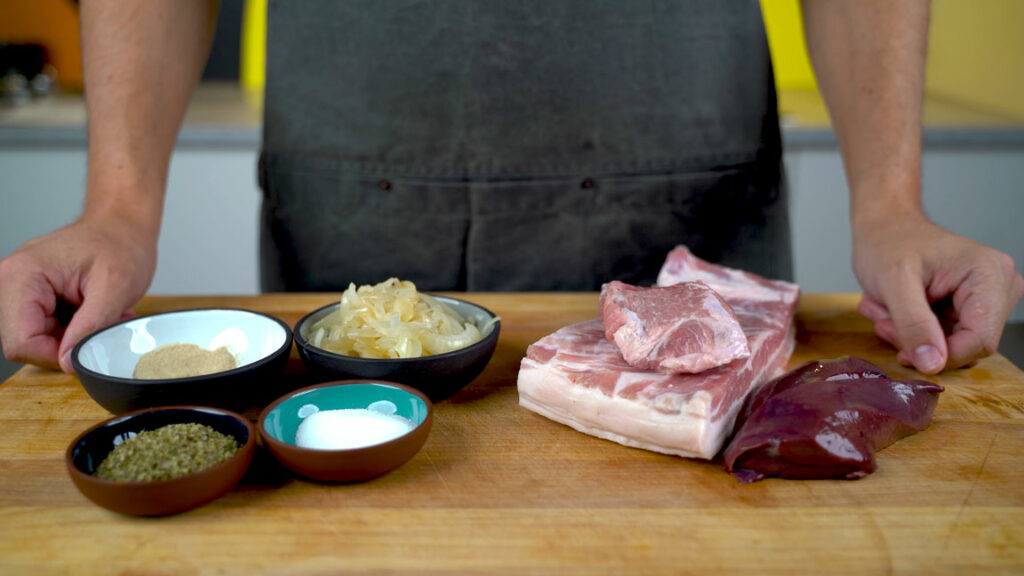
Ingredients for a classic pork liverwurst:
Meat for 1 kg Liverwurst:
60 % pork belly (600g)
20 % pork shoulder (200g)
20 % pork liver (200g)
Spices per kg of meat:
- 17 g Salt
- 2,5 g Cure #1
- 4 g dried marjoram
- 3 g white pepper
- 1 g cardamom
- 0,5g ginger powder
- 0.5g mace
- 160g caramellized onions
Equipment needed to make liverwurst
You need a meat grinder to “grind” the meat. The meat is chopped into small chunks with it.
Food processor / Thermomix
In a food processor, the minced meat and ingredients are mixed into a very fine mass. If you have a Thermomix, you can also use it for this process.
Thermometer & Cooking Pot / Sous Vide Cooker
The easiest way to cook the meat is to use a Sous Vide Cooker. This way you can cook the meat gently in a vacuum bag. Don’t you have a home? No problem! Use a saucepan and heat the water. To reach the exact temperature, you will need a thermometer. Both variants achieve the same result.
Preserving jars / casings
Since I fill the liver sausage into jars, I used jars for this purpose. Alternatively you can fill the mixture into a casing or a can. You can find more information about this in this article.
Homemade liverwurst – Step-By-Step Instruction
1. Cut the meat and fat into pieces suitable for mincing. You can adjust the size for your grinder.
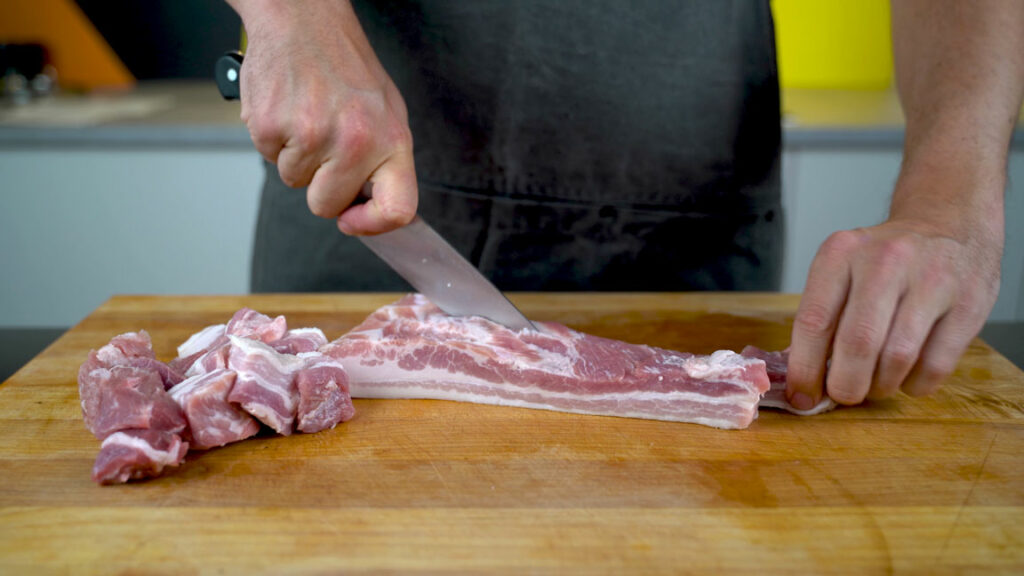
2. Put the pieces of meat into a sealable plastic bag or vacuum seal them.
Note: If you vacuum seal/put the meat pieces in a plastic bag, you won’t lose any liquid into the water and you won’t need cooking stock for the sausage afterwards because all the liquid will stay in the vacuum bag with the fat and liquid that comes out. (If you want to cook your meat without plastic, I explain how it works and what to look for below)
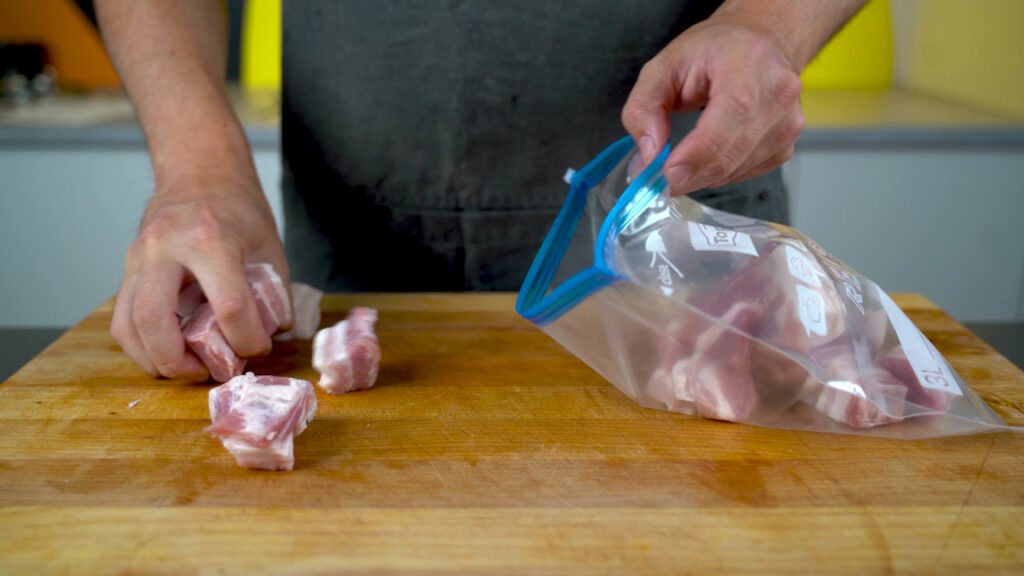
3. Now put the bag in the tempered water or in the sous vide cooker and cook the meat and fat at 78 degrees Celsius (173 Fahrenheit) for 90 minutes.
How do I cook the meat without the sous vide stick and bag?
No problem. You have to weigh the meat once before cooking. Then, after cooking, weigh the meat again and note how much liquid the meat has lost. You add this missing liquid later. You can use the broth in which you cooked your meat.
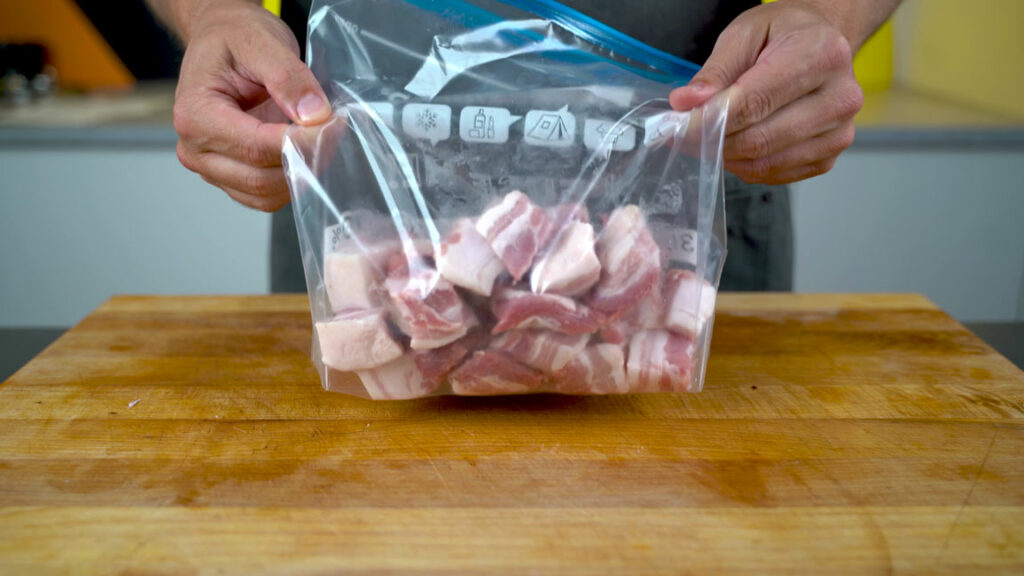
4. Cut the onions into small pieces and let them stew slowly for up to 10 minutes until translucent.
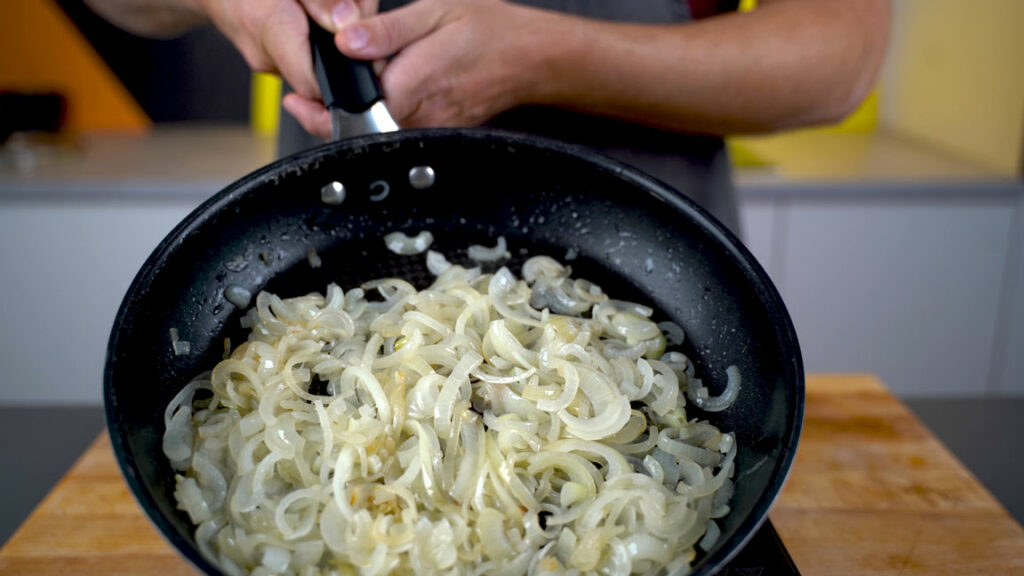
5. Grind the spices to a fine powder. Optionally, you can grind the marjoram. Depending on how fine you want it. This is completely a matter of taste.
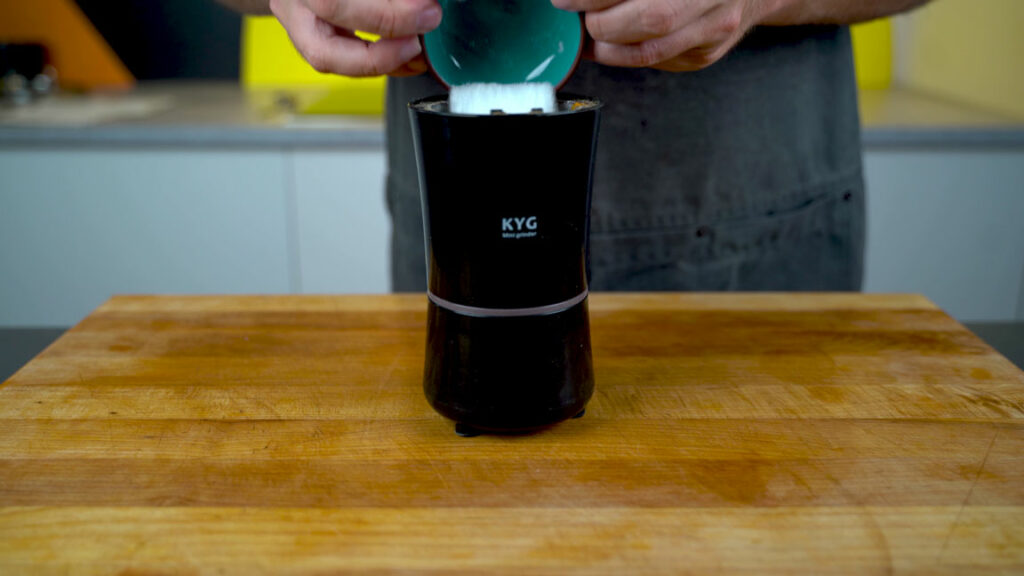
6. Once the meat pieces are cooked and cooled down a bit, you can separate the meat and juices.
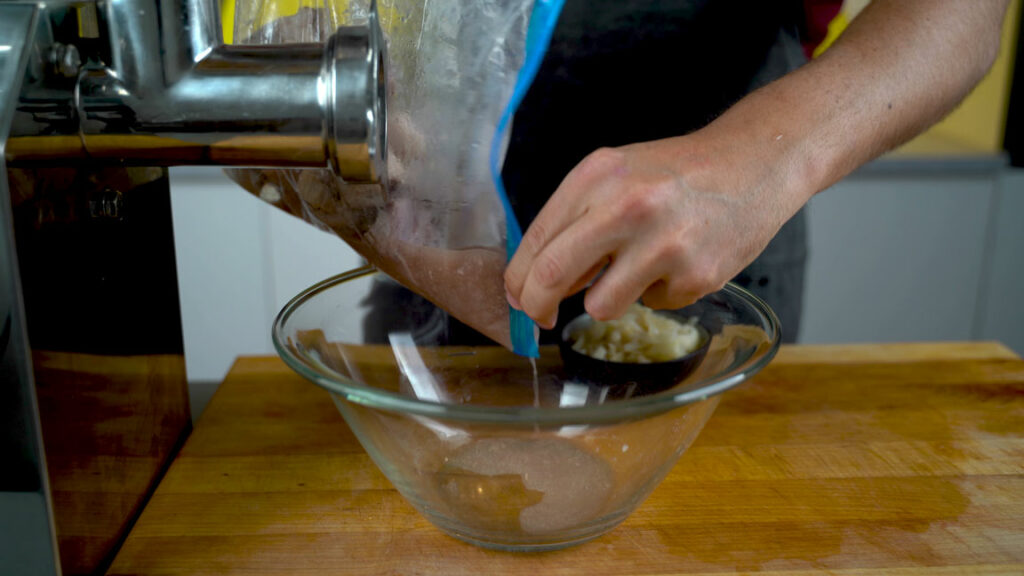
7. First, put the liver through the grinder. Once that’s gone through, you can put the meat and onions through. I personally use the finest perforated disk.
Optional: If you want to tone down the flavor of the liver a bit, then you can poach it for about 5 minutes before mincing. This will soften the strong flavor of the liver a bit.
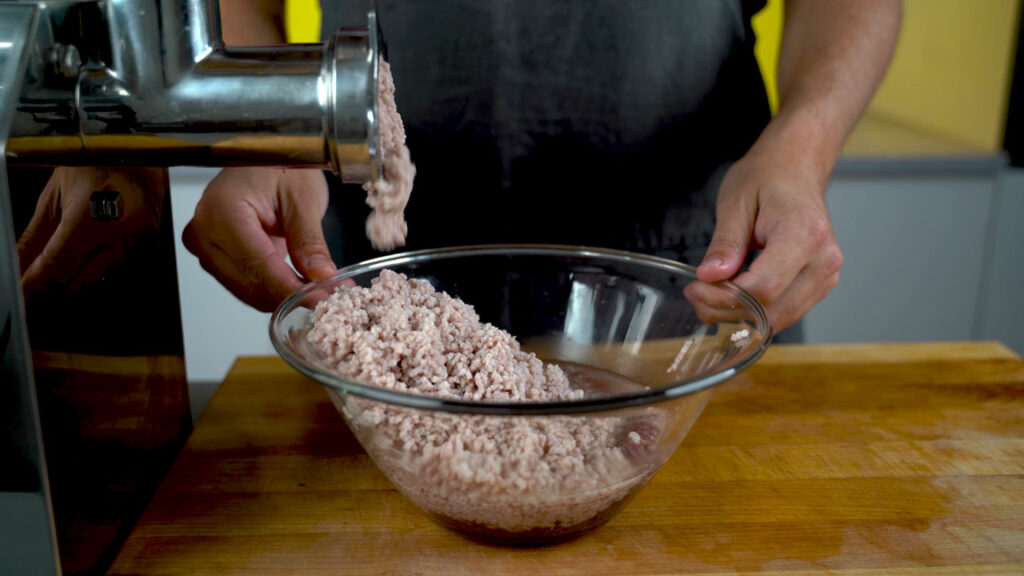
8. Then add the spices to the minced mass and mix it all together.
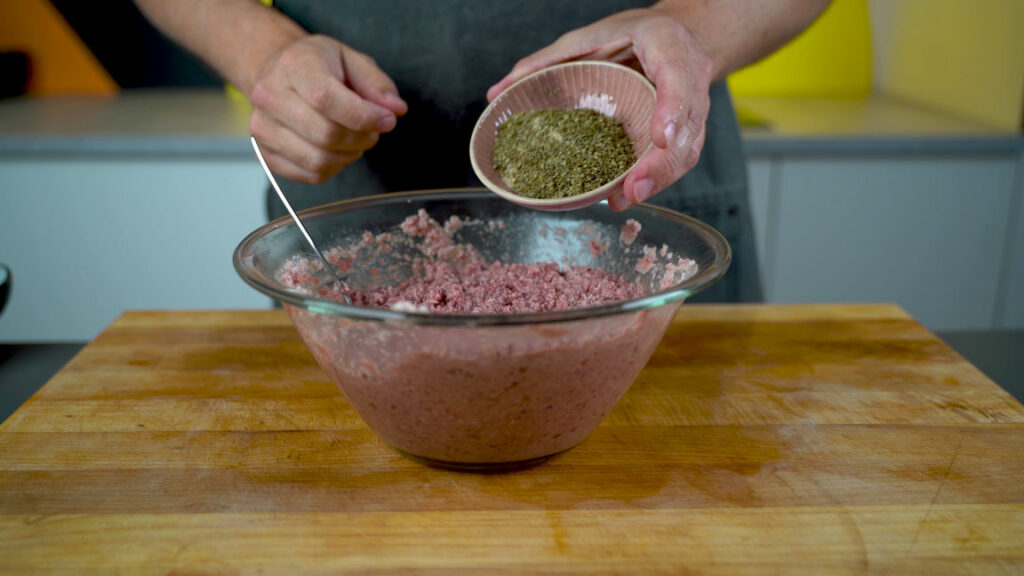
9. Your liver sausage mixture is ready, if you want a coarse liver sausage. If you want it finer, you can still put it in a food processor and blend it fine.
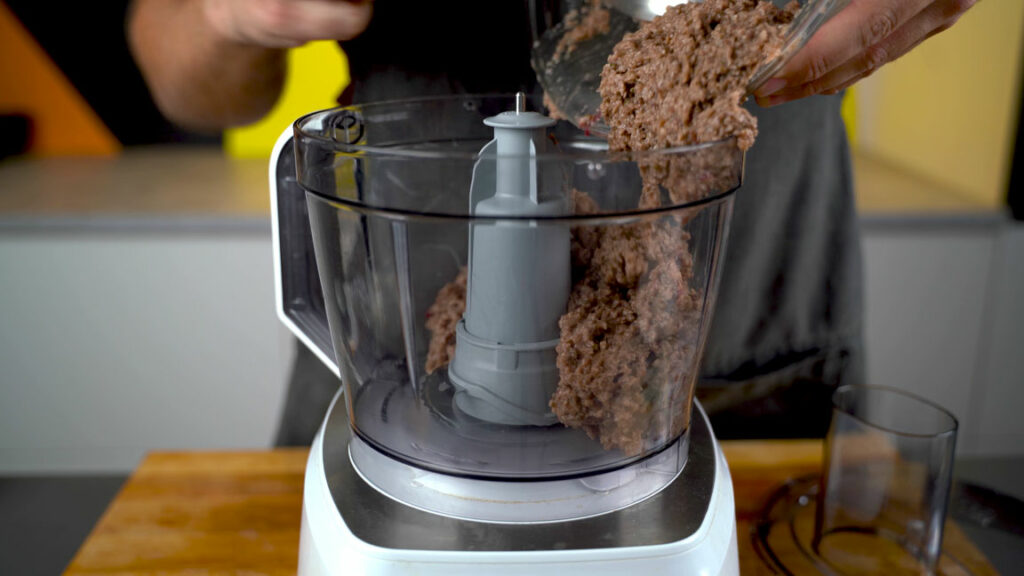
10. You can now fill the mixture into jars or casings. Make sure the mixture is tight and without air holes in the jars. Leave at least a fingertip of space so that the liverwurst can expand as it cooks and it doesn’t overflow.
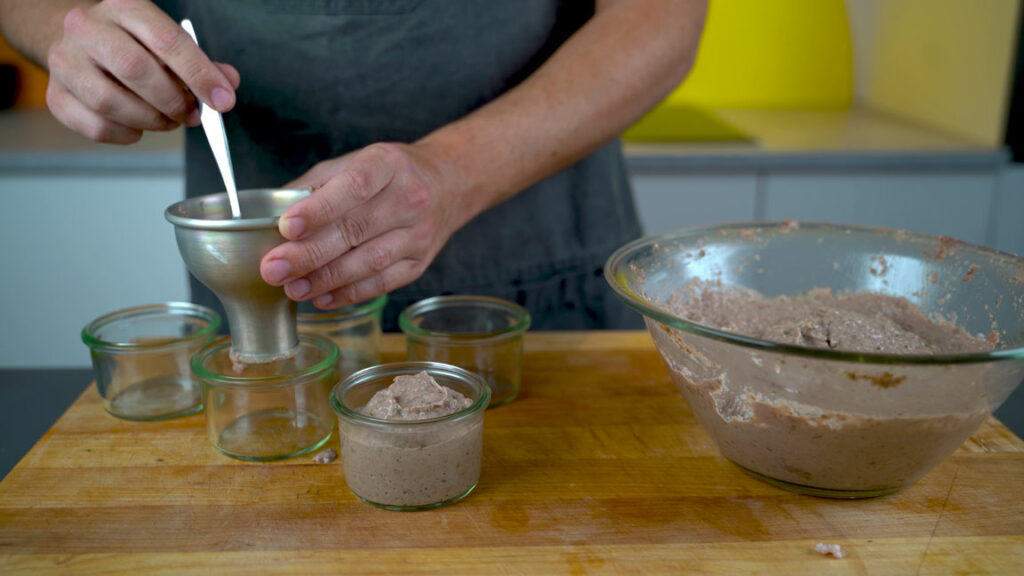
11. Now you have to cook the sausage at 100 °C (212 Fahrenheit) for 2 hours. If you want to use a casing, you can scald it at 80 °C (176 Fahrenheit). The time depends on the diameter of the caliber used. Means: If you use caliber 45, then you scald the liver sausage approx. 45 minutes.
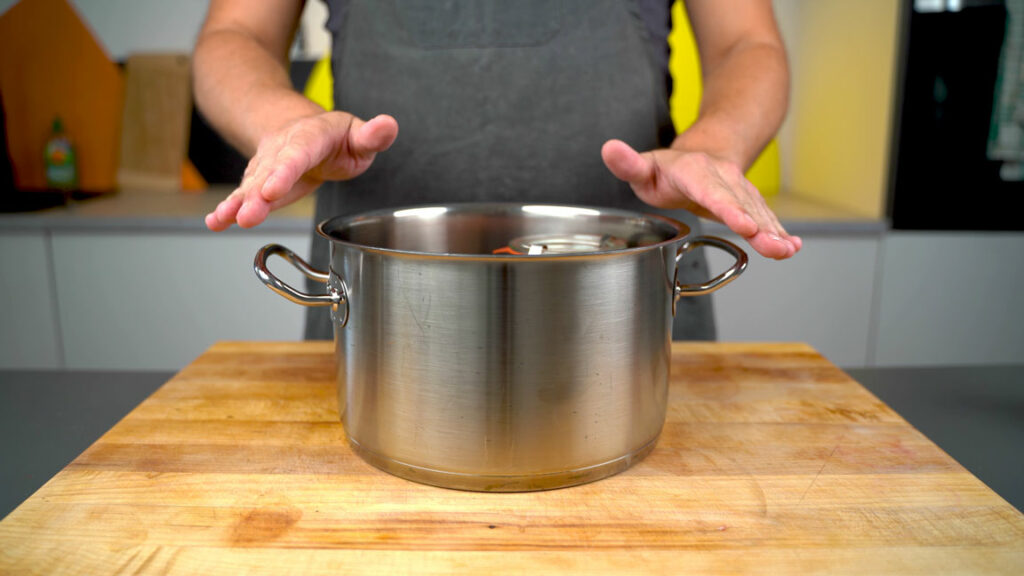
12. Your liverwurst is ready :). Enjoy it
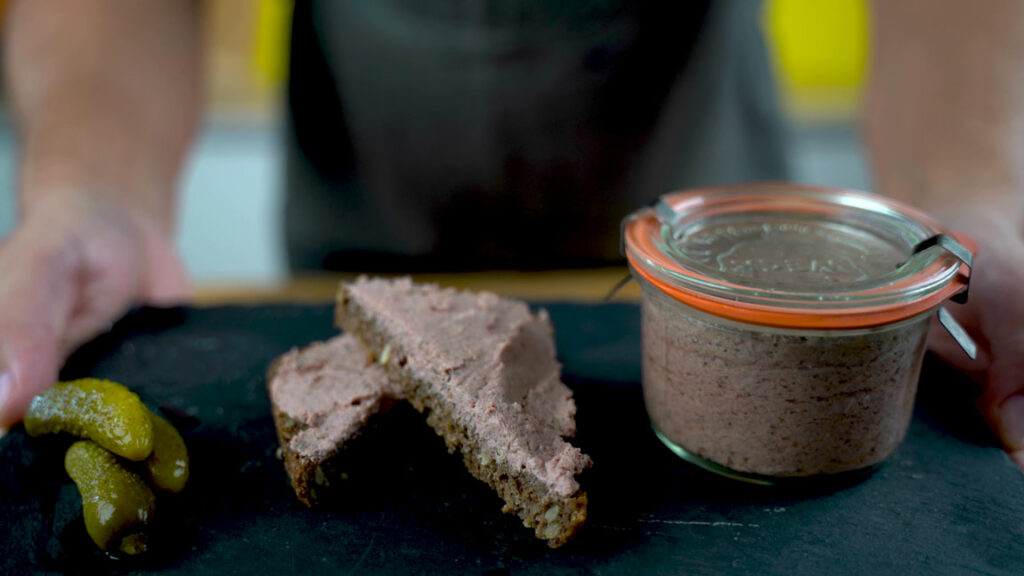
4 Additional liverwurst recipes for you
Veal liverwurst – Super elegant taste
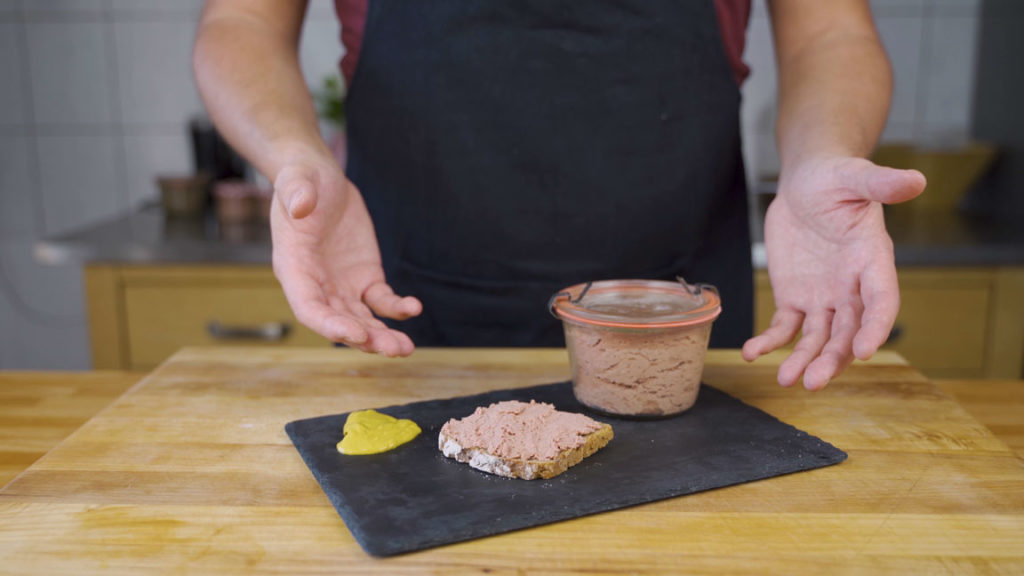
Meat for 1 kg Veal liverwurst:
- 500 g faty veal cuts
- 200 g pork belly
- 150 g calf’s liver
- 150 g pork liver (Alternatively, double the amount of calf’s liver. However, the taste will become stronger and can be unusual)
Spices per kg of meat:
- 18 g Salt
- 2,5 g Cure #1
- 60g caramelized onions
- 2 g white pepper
- 2 g mace
- 0.5 g cardamom
- 0.5 g ginger
You can read the full step-by-step recipe or watch the video here.
Hausmacher Pfälzer liverwurst – A german regional classic
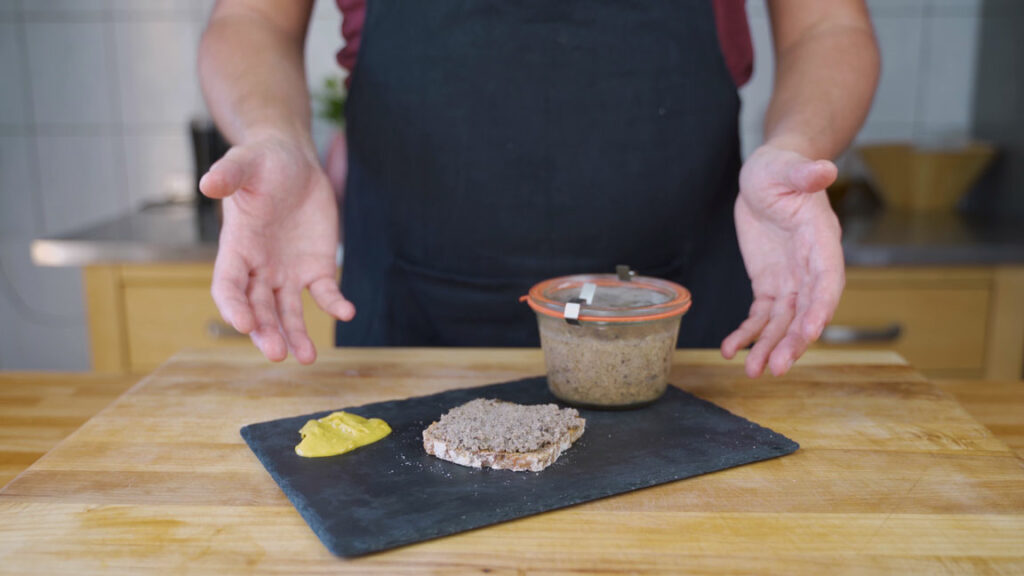
Meat for 1 kg Pfälzer liverwurst:
- 500 g pork belly
- 200 g pork butt
- 300 g pork liver
Spices per kg of meat:
- 18 g Salt
- 2,5 g Cure #1
- 4g marjoram
- 3g white pepper
- 2g sugar
- 2g nutmeg
- 1g allspice
- 1g clove powder
- 75g onion (fried in butter until transparent)
You can read the full step-by-step recipe or watch the video here.
Apple-Onion Liverwurst with a twist of sourness
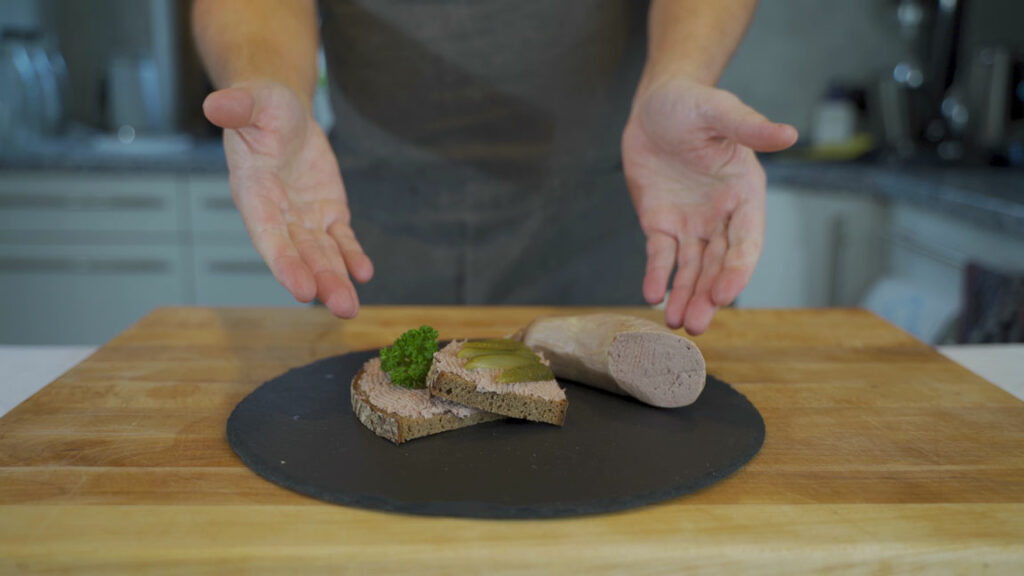
Poultry liverwurst – Awesome variation
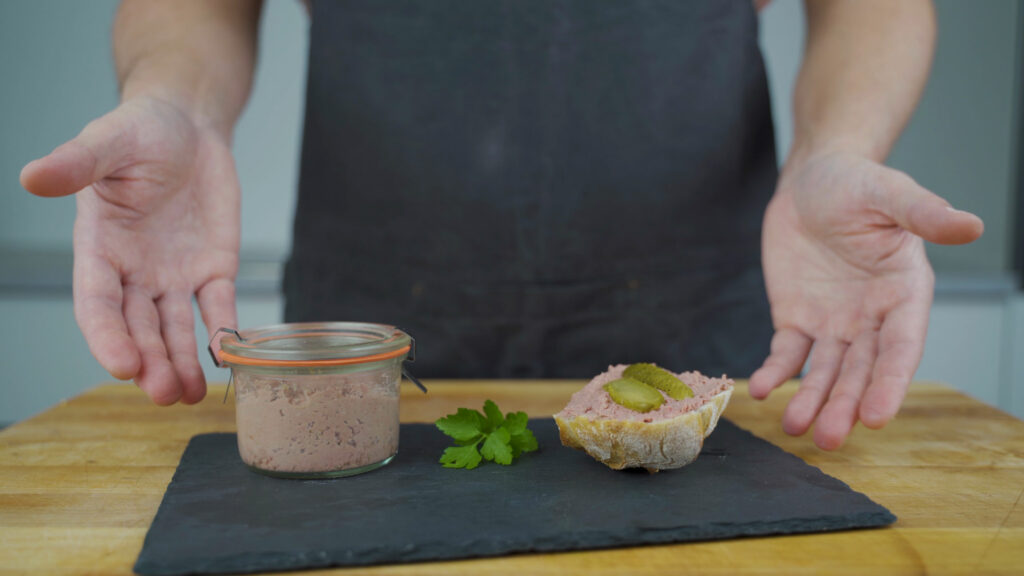
Check out the poultry liverwurst recipe here.
Frequently asked questions about making liverwurst yourself
What is the shelf life of liverwurst?
In theory, the preserved liver sausage can be kept up to a year in a jar or can. However, I do not think it will last so long, because of the delicious taste.
It is best to store the liver sausage in a cool and dark place.
When opening, the rule is:
See it, smell it, taste it!
If you use a casing, you should store the liver sausage in the refrigerator and consume it within a maximum of 10 days.
Make liverwurst without a meat grinder
You would like to make your own liver sausage, but don’t have a meat grinder at home and don’t want to buy one?
Then I have here 2 variations how you can make liver sausage without a meat grinder.
- Ask your butcher if he can grind the ingredients for you. If he doesn’t want to grind the liver, because he has to clean his meat grinder afterwards, let him grind the other ingredients for you and put the liver in the food processor at home.
- Follow all the steps according to the instructions until you reach the point where the meat has to go into the meat grinder. Here you can easily cut your meat into very small pieces and then add it to the food processor. This takes longer, but it also works. My advice here: The liver sausage is coarser, but tastes just as delicious!
What goes into a liver sausage?
Liver sausage contains liver, meat, fat and spices of your choice.
Which spices aere in liver sausage?
This can be very different and depends on the type of liver sausage. In a Franconian smoked liver sausage, for example, marjoram is in the foreground. In a veal liver sausage, more subtle spices.
How much liver should be in liver sausage?
In general, it can be said that liver sausage has a liver content of between 10% – 35%, depending on the recipe.
Tips & Tricks for making liverwurst at home
- The Cure #1 is used to preserve your liver sausage and give it a fragrant color. If you want to work without the Cure you can use normal salt instead. The color will change however the taste will be the same.
- Do you want to cook the meat without the Sous Vide method? No problem. You have to weigh the meat / fat mixture before cooking. Then weigh the meat again after cooking and note how much liquid the meat has lost. The missing liquid needs to be added to the food processor in the blending process. You can use the broth in which you cooked your meat
- You want to use a casing? Then I recommend plastic casings, caliber 60/50.
- If you use a casing, you have to poach the liverwurst per mm diameter for 1 minute at 80 °C (176 Fahrenheit). So caliber 60/50 needs to be poached 60 minutes.
- If you use a can (400g), it will take about 2 hours at 100 °C (212 Fahrenheit) to preserve.

My wife and I really love liverwurst. I will be making this recipe. So far I have made Trail Balogna, 3 different kielbasas, The Chriustmas one is the best. krukuska, (a polish sandwich meat). Andouille, Bodine, Summer sausage. Chorizo, (Tex-Mex style).. There is a fellow right by me that makes the best brats so I have not tried my hand at them yet
Sounds awesome. Let me know how it worked out!
Thank you for your step by step guide! I tried it yesterday and my liverwurst came out very yummy. I used ingredients from a combination of your recipes (Mace, Cardamom, Marjoram, White Pepper, Ginger, Sugar, Salt, and Caramelized Onions) and modified the meat sources (Turkey Liver, Ground Turkey, and Fatty Beef Bacon).I follow your steps using the Sous Vide method and food processor (excellent consistency , but I didn’t have casings or glass jars for the final cooking step. I used a sealable plastic bag again. Unfortunately the side of the bag ruptured, causing the liverwurst mixture to be watery and bound together. I will use glass jars next time. Since I didn’t use this step, I don’t know what the final liverwurst consistency is. Does it come out solid (bound) or more like a pate?
What is Cure #1? Is there an alternative name?
It will be a spreadable sausage. Not firm. You can skip the Cure in this recipe if you cook them in jars. The color will be more greyish but taste the same.
Cheers
Daniel
Love your site!
Could this recipe be turned into a braunschweiger type variation and be smoked?
What would you recommend if it’s possible? Just use smokable casings and cold smoke after the poach?
Thanks in advance!
Hey John, yes exactly. The way you described it is on point. Cheers Daniel
Do you have any advice on using an InstantPot pressure cooker to do the jars? I was thinking it might make a vacuum & preserve better… without Cure #1 (I am nitrite sensitive, & assume this is what is in it), do jars still keep as long? Should they be refrigerated? One last thing… I have a vacuum sealer with a mason jar lid adapter, which would remove all air from my jars, but is it safe to heat them like that (or should I seal after cooled)? Thank you for a very high quality video… you did such a lovely job on it!
Hey Barbara,
yes you can pressure cook them. I do not think that you need to vacuum seal the mason jars with any extra equipment. You do not need the cure #1. Color will change but shelf life will be same if correctly canned / cooked in jars.
Hello Daniel – can I use “baking” the jars in an oven at 225 Def F rather than on the stovetop with jars submersed in water ?
Sounds great and easy can’t wate to try it myself
Grüss Gott!!
I have made my own liverwurst in Germany with my German Mother-in-law, my wife and the local Metzger in Oma’s Küche.
This is by far the closest recipe I have seen searching far and wide to what we made. I do plan to skip the cure salt (aka pink salt) as I prefer the grayish color and to me the taste is best without.
We never used sous vide, we actually had what we called a kessel brue (sp) pot. This is roughly a pot full of hot water the size of a very large washing machine. We ran water into it and heated it to cooking temperatures with a wood fire and by feel.
It sounds perhaps primitive – this was the late 80’s through the 90s time frame – and in all honestly, I gained 30 pounds the first year my skinny behind was married to my beautiful bride now of 33 years……..
We made a variety of sausages, Brats, Headcheese (not sure why its called that, there was no cheese, blood, white, and of course the liverwurst.
We started at 5am and by 8 am we were eating raw (yeah yeah I know but we did it) bratwurst on schwartzbrot, mit zwiebel and a nice pilsner beer for breakfast…..
Ok, sorry, I have to go eat because now I have made myself hungry!!
Is there away to smoke the liver wurst?
yes there is, will post a recipe in a few weeks. short version: 2 x 8 hours of cold smoking after poaching.
Made my first batch19lbs of liverwurst using your recipe, I wanted to preserve it for long term storage so I put the liver sausage in pint jars and pressure canned them for 77 minutes at 15 lbs pressure,the sausage came out grainy,before I put the sausage into the jars it was smooth and creamy the taste is the same before and after but it is not as pleasant to eat. I think the fat got cooked out and the meat clumped together. How can I preserve the liverwurst for long term storage 1to 1.5 years without freezing it.
Typically cooking it in jars for 2 hours will work fine as stated in the video. I am not sure about pressure cooking. Never tried it.
Hey Daniel, thanks for this recipe. I gave it a whirl and just finished boiling my jars of liverwurst.
Of course, I modified your recipe to work with what I had available (which may have ruined or impacted it) – I have a question:
My finished jars of liverwurst have a small amount of pooled red liquid at the bottom (underneath the liverwurst). Very thin, much thinner than blood or meat juices that I would have expected. The top of the jars still has a pocket of air, so I know that water didn’t leak in. Have you run into this before?
I’m wondering if the problem was that I substituted 85% lean ground beef for the pork shoulder (I modified the pork belly and back fat ratios to hit approximately the same overall fat content. I know that beef liverwurst exists, so I wasn’t expecting this much of a difference compared to your product!
Any advice would be appreciated. I’m still waiting for the jars to cool so I haven’t taste tested but I’ll let you know how it goes.
Thanks!
Hey Robin, diagnosis from afar is always a bit hard. Did you measure out the liquid you put back in? How was the spreadability of the liverwurst. The only thing I could Imagine is that you put too much liquid back in?
Two questions:
1) What’s the point of boiling the jars if you’ve already cooked (sous vide) to 170 degF?
2) What internal temperature should the jars be boiled to?